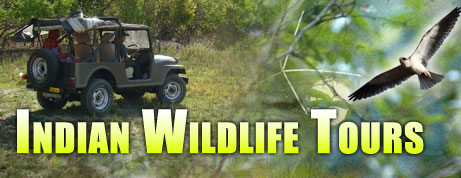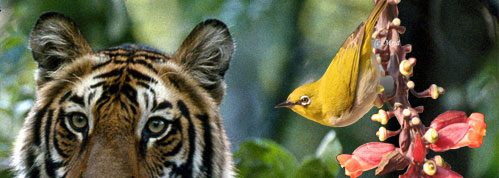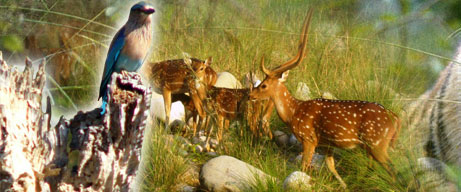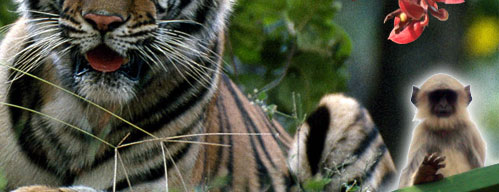Wild Species In India
Indian Crane
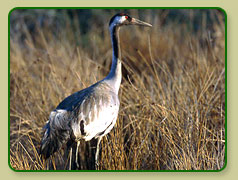 The
Sarus Crane is the only resident breeding crane in India and southeast
Asia, and is the world's tallest flying bird. It is also India's largest
bird.
The
Sarus Crane is the only resident breeding crane in India and southeast
Asia, and is the world's tallest flying bird. It is also India's largest
bird.
The Sarus crane is the world's tallest flying bird; a large male may stand six feet tall. There are three recognized subspecies of the sarus crane. The Indian sarus cranes live, as their name implies, predominately in Asia's subcontinent. In areas dominated by the Hindu religion, the Indian sarus suffers little persecution. They have, as a result, lost much of their fear of humans and often nest in rice paddies where they are regarded as omens for good crops, especially in India.
Eastern sarus cranes were once abundant in Southeast Asia, but after decades of war they are missing from most of their former range. The few that remain nest in Cambodia in small wetlands surrounded by dry forest, but migrate to Viet Nam's lower Mekong Delta to winter at the Tram Chim National Reserve. There is a smaller non-migratory population, discovered by ICF staff in 1996, that lives in Myanmar's Irrawaddy delta. The third subspecies is the Australian sarus crane.
Range
Three populations of the Sarus Crane are currently recognised and each occupies a distinct range. The Indian Sarus Crane population is found in Pakistan, northern and central India and Nepal.
Habitat
Northern and central India, southeastern Pakistan, southern Myanmar, Cambodia, southern Laos, Viet Nam, and northern Australia. The Philippine population of sarus cranes is probably extinct.
Status
Despite cultural and religious protections, sarus cranes are vulnerable in most areas. Roughly 8,000 to 10,000 Indian sarus remain, though the population is declining due to the loss of wetlands and increasing amounts of pollution as the human population continues to grow. The greatest concentration of Indian sarus cranes occur where land use practices have changed little from traditional patterns. Some fear that the whole wetland food web on which sarus cranes depend may be under stress as pesticides and fertilizers become more widespread in the subcontinent's rural areas. Even in India's Keoladeo National Park, the number of sarus nests has decreased since the early 1980s.
The Eastern sarus population in Southeast Asia is estimated at 500 to 1,500 birds. This subspecies is subject to hunting, pollution, warfare, heavy use of pesticides, and development of the Mekong River. A rapidly growing human population threatens to overwhelm areas that these cranes rely on. There is also trade in and hunting of both chicks and adult birds in some areas.
Flight and Migration
Cranes typically run into the wind to achieve the lift necessary for flight, but if alarmed a crane can spring directly into flight. Cranes may fly as fast as 52 m.p.h. during level, flapping flight, but prefer to soar, especially during migration. When soaring in thermals (updrafts of warm air), cranes will circle until they reach a desired altitude, usually between 3,000 and 5,000 feet. Once the appropriate altitude is reached, the cranes leave the thermal and glide forward, slowly losing altitude. They then find another thermal and repeat the procedure. While slower than level flapping flight, soaring conserves energy. Cranes prefer to migrate at altitudes of less than 5,000 feet, but some species are forced to fly much higher. In North America, mountain ranges run north and south and birds migrate parallel to them. In Asia and Europe, however, mountain ranges, such as the Himalayas and Pyrenees, generally run east and west forcing cranes and other birds to negotiate mountain passes as high as 20,000 feet.
Daily flights may range from a few miles in bad weather to several hundred miles if suitable stopover points are unavailable
 The
Sarus Crane is the only resident breeding crane in India and southeast
Asia, and is the world's tallest flying bird. It is also India's largest
bird.
The
Sarus Crane is the only resident breeding crane in India and southeast
Asia, and is the world's tallest flying bird. It is also India's largest
bird.The Sarus crane is the world's tallest flying bird; a large male may stand six feet tall. There are three recognized subspecies of the sarus crane. The Indian sarus cranes live, as their name implies, predominately in Asia's subcontinent. In areas dominated by the Hindu religion, the Indian sarus suffers little persecution. They have, as a result, lost much of their fear of humans and often nest in rice paddies where they are regarded as omens for good crops, especially in India.
Eastern sarus cranes were once abundant in Southeast Asia, but after decades of war they are missing from most of their former range. The few that remain nest in Cambodia in small wetlands surrounded by dry forest, but migrate to Viet Nam's lower Mekong Delta to winter at the Tram Chim National Reserve. There is a smaller non-migratory population, discovered by ICF staff in 1996, that lives in Myanmar's Irrawaddy delta. The third subspecies is the Australian sarus crane.
Range
Three populations of the Sarus Crane are currently recognised and each occupies a distinct range. The Indian Sarus Crane population is found in Pakistan, northern and central India and Nepal.
Habitat
Northern and central India, southeastern Pakistan, southern Myanmar, Cambodia, southern Laos, Viet Nam, and northern Australia. The Philippine population of sarus cranes is probably extinct.
Status
Despite cultural and religious protections, sarus cranes are vulnerable in most areas. Roughly 8,000 to 10,000 Indian sarus remain, though the population is declining due to the loss of wetlands and increasing amounts of pollution as the human population continues to grow. The greatest concentration of Indian sarus cranes occur where land use practices have changed little from traditional patterns. Some fear that the whole wetland food web on which sarus cranes depend may be under stress as pesticides and fertilizers become more widespread in the subcontinent's rural areas. Even in India's Keoladeo National Park, the number of sarus nests has decreased since the early 1980s.
The Eastern sarus population in Southeast Asia is estimated at 500 to 1,500 birds. This subspecies is subject to hunting, pollution, warfare, heavy use of pesticides, and development of the Mekong River. A rapidly growing human population threatens to overwhelm areas that these cranes rely on. There is also trade in and hunting of both chicks and adult birds in some areas.
Flight and Migration
Cranes typically run into the wind to achieve the lift necessary for flight, but if alarmed a crane can spring directly into flight. Cranes may fly as fast as 52 m.p.h. during level, flapping flight, but prefer to soar, especially during migration. When soaring in thermals (updrafts of warm air), cranes will circle until they reach a desired altitude, usually between 3,000 and 5,000 feet. Once the appropriate altitude is reached, the cranes leave the thermal and glide forward, slowly losing altitude. They then find another thermal and repeat the procedure. While slower than level flapping flight, soaring conserves energy. Cranes prefer to migrate at altitudes of less than 5,000 feet, but some species are forced to fly much higher. In North America, mountain ranges run north and south and birds migrate parallel to them. In Asia and Europe, however, mountain ranges, such as the Himalayas and Pyrenees, generally run east and west forcing cranes and other birds to negotiate mountain passes as high as 20,000 feet.
Daily flights may range from a few miles in bad weather to several hundred miles if suitable stopover points are unavailable
